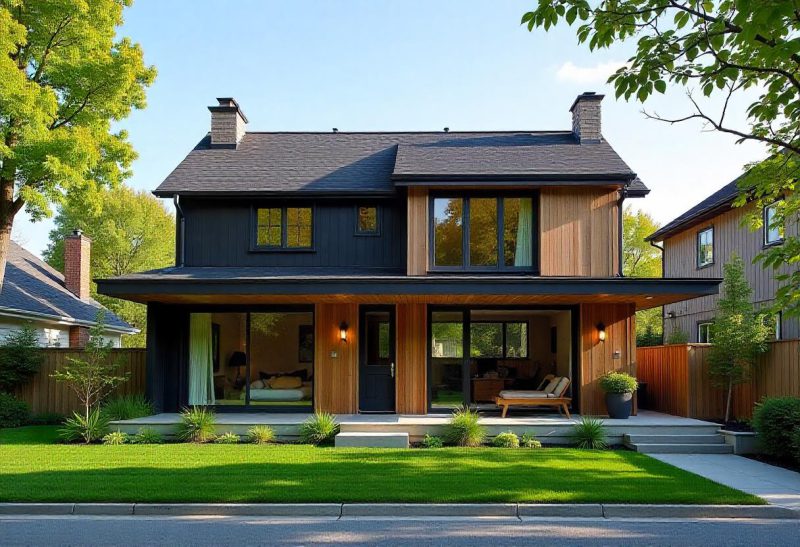Understanding Toronto’s Zoning Regulations for Home Additions
- Residential Zones (R): In most neighborhoods, properties are zoned for residential use. These zones regulate height restrictions, building setbacks, and the total allowable floor area for home additions.
- Density Regulations: If you are planning an addition that significantly increases your home’s size, you must ensure that your project complies with the permitted Floor Space Index (FSI), which limits how much of your lot can be covered by buildings.
- Neighbourhood-Specific Rules: Different neighborhoods, particularly older or established ones, may have stricter regulations, especially concerning preserving the character and aesthetic of the area.
Understanding these regulations early on helps you gauge whether your home addition is feasible within the city’s legal framework.
The Permitting Process for Home Additions in Toronto
Once you’ve checked the zoning laws, the next thing to do is to get the right permits. The process of getting permits for adding onto your home in Toronto has multiple steps and needs detailed documentation.
1. Pre-Application Consultation:
It’s a good idea to meet with the city planners before you submit your formal application for a home addition permits. This meeting will help ensure that your project complies with all zoning and building regulations, which can save time and prevent issues down the road.
2. Required Documentation:
- Architectural Plans: You’ll need detailed architectural drawings that comply with Toronto’s building codes. These plans should include floor layouts, elevations, structural details, and material specifications.
- Zoning Certificate: A zoning certificate ensures your project meets zoning regulations for your property. It’s a prerequisite for obtaining a building permit.
- Building Permit Application: Submit your application with all required documents to the Toronto Building Division. This application is necessary for any Home Addition Toronto that involves structural changes.
- Heritage or Conservation Area: If your property falls under a heritage or conservation district, you may need additional approvals and documentation, including a Heritage Permit.
3. Permit Approval:
The approval process for your home addition permits can vary in duration, ranging from a few weeks to several months, depending on how complex the project is. Be ready to supply additional information or make revisions if needed.

Overcoming Challenges with Heritage Properties, Laneway Suites, and Infill Construction
Every Home Addition Toronto project comes with its unique challenges, especially when dealing with heritage properties, laneway suites, and infill construction.
Heritage Properties
If your house is located in one of Toronto’s older neighborhoods and is considered a heritage property, you’ll have to follow strict regulations. To add an extension to your home, you’ll need to collaborate with Toronto Heritage Preservation Services and local authorities to make sure that your new addition fits in with the historical preservation rules. This means that the design, materials, and structure of your addition should match the historical style of the original building.
Laneway Suites
Laneway suites provide a creative way to expand homes in Toronto by transforming garages or small buildings on the property’s laneway into living areas. However, building these suites requires adhering to specific zoning regulations and obtaining special permits. Laneway suites must meet certain size, height, and setback criteria, and also need to have access to essential utilities such as water and electricity.
Infill Construction
When it comes to infill construction, it means adding new buildings to areas that are already developed, usually on smaller lots or in spaces between existing buildings. In Toronto, the key issue with infill construction is making sure that any new home additions fit in well with the surrounding neighborhood and don’t disrupt the overall feel of the area. To do this, it’s important to carefully plan the construction and make sure it follows all the rules and regulations about things like how close buildings can be to each other and the street.

Tips for Working with Local Authorities and Architects on Home Addition Toronto Projects
Working closely with local officials and experienced professionals such as architects and construction experts is crucial for the success of your home expansion project. Here are some pointers to help guarantee a seamless process:
1. Hire Experienced Professionals: Working with a seasoned contractor such as Maple Star Builders guarantees that your project adheres to all local regulations and codes. We have a solid grasp of Toronto’s zoning laws and a history of completing home addition projects successfully.
2. Work with Local Architects: Local architects in Toronto are well-versed in the city’s zoning regulations. They can assist in ensuring that your architectural designs comply with building codes and are in harmony with the aesthetics of your neighborhood, particularly if your property is located in a heritage or conservation area.
3. Communicate Clearly with City Planners: It’s important to stay in touch with the city’s planning and building departments to make the permitting process faster and prevent any confusion. Make sure to submit all the necessary documents accurately and on time to avoid any delays, and schedule inspections in advance to avoid any expensive problems.
4. Plan for Flexibility: Zoning and permitting rules can sometimes lead to unexpected roadblocks. Be prepared to adjust your plans to accommodate any concerns raised by local authorities.
Final Thoughts on Navigating Home Addition Permits and Zoning Laws
Navigating the zoning laws and permit process for adding onto your home in Toronto can be complicated, but the benefits of a well-executed project are definitely worth it. By understanding the local zoning rules, making sure you have the right permits, and teaming up with experienced professionals like Maple Star Builders, you can avoid common issues and successfully complete your home addition project. Whether it’s adding a laneway suite or expanding your main home, a successful renovation starts with careful planning, preparation, and working closely with experts.
References:
City of Toronto. (n.d.). Toronto Building Division: Building Permits & Zoning Information. Retrieved from https://www.toronto.ca/city-government/accountability-operations-customer-service/city-administration/staff-directory-divisions-and-customer-service/toronto-building/
City of Toronto. (n.d.). Zoning By-law 569-2013: Comprehensive Zoning By-law. Retrieved from https://www.toronto.ca/city-government/planning-development/zoning-by-law-preliminary-zoning-reviews/
Government of Ontario. (n.d.). Ontario Heritage Act. Retrieved from https://www.ontario.ca/laws/statute/90o18
City of Toronto. (n.d.). Laneway Suites Program. Retrieved from https://www.toronto.ca/city-government/planning-development/planning-studies-initiatives/


